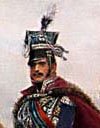When playing in a tabletop miniatures game I like to do at least a little of both, preferably getting into the 'fighting' part with artillery at least on the first or second turn.

Any game that is all marching/maneuver/arrivals/etc for more than 3 turns will rapidly become a bore-fest that quickly looses my interest.
Should the game start with no room to move at all, with the troops standing shoulder to shoulder with no breaks in the line and no point to want to break that line also will be a bit of a bore-fest, doubly so if there is no incentive for either side to move towards one another. All you get there is either a long series of artillery shots back and forth, or one player gets bold (or bored) and decides to charge the other (whether an intelligent choice or not sometimes).
Therein lies the difficulty in designing a game where a balance between action (movement of troops and shooting) and inaction (the same-old same-old again and again).
This is where we are with the engagement coming up at Unter-Schweingau, trying to make a 'game' of the encounter, with some entertainment beyond the usual.
With an 'arrivals' game, I see a long line defending the river bank (in depth) and no hope for the attackers to get much past the town before 20 or more turns have passed.
With too many troops standing in defence of the town then the attackers cannot 'get into action' without running off the tabletop again and again as the 'artificial' space limitations keep getting in the way of the needed flanking actions.
Have other players come into these sort of thoughts when planning a game?





























.jpg)























4 comments:
There is much to be said for a game that starts with troops already "in contact" . . . but it does leave out the command problems of maneuver.
I recall a big ACW game I was involved in a couple of decades back. It started with two divisions on table . . . but the other six of us were off-table.
At the end of the session some six hours later, four of us had yet to get to where we could even shoot at the enemy.
Definitely the wrong scenario for the rules we were playing ("Johnny Reb").
I agree about the current map of Unter-Schweingau . . . if Arnold's forces are coming from the east, the fight could be long and bloody . . . but also not very exciting because there's only one bridge over the river.
We have time . . . perhaps Jonathan might reconsider his map.
I'd find a crossroads situation more interesting, where the attacker dices for which road he enters on and the defender then has to react . . .
. . . or have a number of possible objectives spread out a bit over the table and have the defender worry about what the goal really is.
But it doesn't matter, we'll fight out whatever he decides . . . after all, they are his forces.
-- Jeff
Yes Jeff,
I agree that they are Jonathan's forces, however I got to this line of thinking in my efforts to try and make something *more* from the basic elements we have to start with...
Can you share the map?? Some ther thoughts might be along the lines of the flanking force in the last Table Top Teasre in the last Battlegames?? Arrival of a small force at a random time, where the enemy least expects them to arrive?
Some random cards revealing to the attacker (but not the defender)
1/. the hitherto unknown position of a ford across the river, or
2/. the way round the flank (which ties into the flanking force idea),
..that have been divulged by a bribed local peasant, good recon, etc.?
Sure Steve map is at:
http://ober-schweinsberg.blogspot.com/2008/01/sketch-map-for-unter-schweingau.html
I think Jonathan has prepared this map from the magazine article you are talking about.
Post a Comment